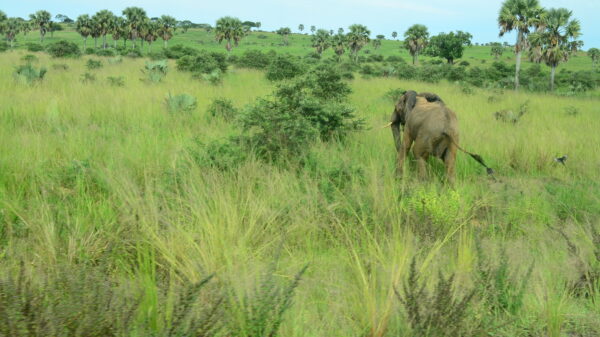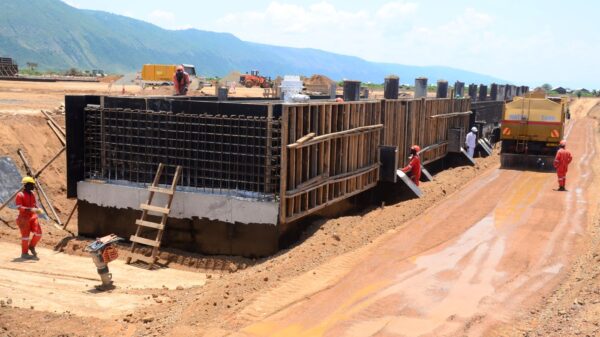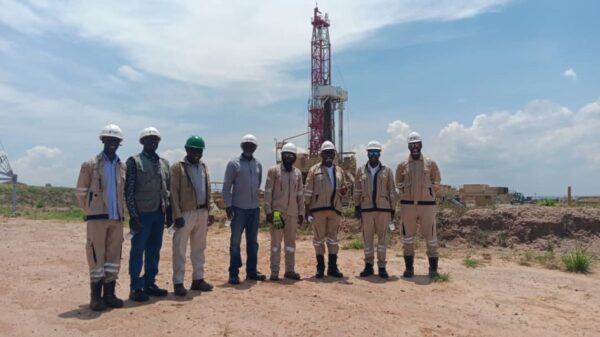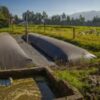Diana Taremwa Karakire –Buliisa District,Uganda
Story supported by Drilled Media with funding from the Pulitzer Center
Total claims it can make up for the biodiversity impacts of drilling in Uganda’s largest national park by preserving biodiversity elsewhere, but local advocates aren’t buying it.
In the middle of the savannah grasslands, a herd of elephants graze by the roadside inside Uganda’s largest national park, Murchison Falls Park. Giraffes, elephants, bushbucks, and buffalo strut across the vast expanses of this savannah. A few meters away, the noise of bulldozers clearing an oil drilling site jars the calm of a sunny June day, as French oil giant TotalEnergies’ long-delayed Tilenga crude oil project roars to life.
“We have co-existed peacefully with these animals for a long time,” said Alex Wakitinti, a senior elder of the Bagungu community, a native tribe that has for generations lived near the rim of the park. “The people, the animals, and the land have always been together.”
These same wild landscapes, however, also host over 6.5 billions of barrels of oil deep underground. In 2023, TotalEnergies kicked off drilling operations in the park as part of its 230,000 barrels-a-day Tilenga project, which by early 2025 will catapult Uganda into the league of top oil producers in Africa. The project includes a central processing facility,feeder pipelines and other infrastructure to support the production of petroleum from six oilfields .According to Petroleum Authority Uganda,the project development will include onshore drilling of 426 wells from 31 well pads (including 10 wellpads located within Murchison Falls Park). Over 100 wells have so far been drilled.
And while environmental advocates and Indigenous communities alike continue to raise concerns about the impact of the company’s operations on biodiversity in the protected area, Total claims not only that it won’t damage the area, but that it will leave it better than it found it and deliver a “net biodiversity gain.”

Drilling activities ongoing at JobiRii well pad at the TotalEnergies’s Tilenga project area inside Murchison falls national park.Photo by Diana Taremwa Karakire.
Ongoing Construction works underway at the Tilenga oil project site, located within Uganda’s largest national park, Murchison Falls. Photo by Diana Taremwa Karakire.
Philippe Groueix, the general manager TotalEnergies Uganda, said that the company conducted an environmental impact assessment for its drilling in 2019, before undertaking any activities in the park.
“We are committed to having a net gain on biodiversity. We have a detailed environment management plan and are working with partners like Wildlife Conservation Society (WCS) and Uganda Wildlife Authority (UWA) to implement it,” said Groueix.
Ultimately, delivering a “net gain on biodiversity” will require biodiversity offsetting—the preservation of natural habitats elsewhere to compensate for the loss of biodiversity in Murchison. But to date, the research on biodiversity credits or offsets doesn’t paint a rosy picture. A 2019 review of available research on the efficacy of “no net loss” approaches to biodiversity, for example, “identified large gaps between the global implementation of offsets and the evidence for their effectiveness.” Writing in the journal Science in 2023, Australian researchers Michael Vardon and David Lindenmayer warned about “the risk that trading ill-defined generic biodiversity credits will result in biodiversity loss, not conservation.”
Total has announced plans to deliver on its biodiversity promises via various conservation actions in line with the mitigation hierarchy, an international framework for environmental mitigation based on four iterative actions: avoidance, minimizing any negative impacts (prevention), before restoring and finally offsetting residual impacts (remediation).
“We work with partners to implement the mitigation hierarchy,” said Pauline Macronald, the Biodiversity Director at TotalEnergies. “Together with partners, we conduct monthly surveys to monitor animal migration patterns. This approach helps us understand how wildlife interacts with our operations. We closely monitor changes in habitat, ecology, and animal behavior within the project footprint.”
Murchison Falls National Park spans 3,893 square kilometers. Established in 1952, the park features diverse ecosystems ranging from wildlife-rich habitats to the iconic Murchison Falls to the Delta, where the Nile River flows into Lake Albert, an important bird area and Ramsar site, supporting vital fish breeding. Several species are recorded within the park including 144 mammal species,556 bird species,several reptiles and amphibians.The park is particularly known for its big population of African elephants, and is rich in cultural and historical sites that hold spiritual significance for Indigenous communities.
Over 50,000 tourists visit MFNP each year, generating over $2 million in tourism revenues. In recent years MFNP has hosted above 30% of all the tourists visiting protected areas in Uganda according to UWA.
In 2013, Total Energies and WCS in collaboration with the UWA began collecting baseline data on elephant movements within Murchison Falls National Park. The goal of this monitoring is to track elephants’ ranging patterns and behavior during different phases of oil and gas development in the park.
But biodiversity experts unaffiliated with the project have been doing similar monitoring, and what they are finding is not a “net positive” impact. An August 2024 report from Africa Institute for Energy Governance, or AFIEGO, for example, found that since production began in Murchison Park in July 2023, drilling noise has driven animals out of the park and into nearby communities, heightening human-wildlife conflicts in the region. Elephants, for example, have trampled and destroyed farmlands and even caused fatalities; the report found that at least five people in Buliisa district, which neighbors the park, were killed by elephants between 2023 and April 2024. Vibrations from the drilling are also agitating the elephants, many of which are sensitive to noise and vibration.
“Oil activities have turned the animals against us. Elephants now stray into our lands more frequently, putting their lives and ours at risk,” Wakitinti warned.

Alex Wakitinti removes his shoes before stepping onto a sacred natural site used for traditional prayers by the Bagungu tribe in Buliisa District. Photo by Diana Taremwa Karakire
The report found that increased motor traffic in the park has also led to road accidents risks faced by wildlife. Construction of road networks has further opened up the park and increased human activity within the park, which poses significant conservation risks for wildlife, as these roads provide easier access for poachers.
“In January, an oil gravel dump truck knocked down two elephants,” said Diana Nabiruma,a spokesperson for AFIEGO. “This has a lot to do with animal ranging patterns. Drilling is taking place in elephant home ranges.”
Ultimately, AFIEGO recommended that TotalEnergies halt all operations in the park and called on the UNESCO World Heritage Committee to engage with the Ugandan government to cease oil activities in this critical biodiversity hotpot.
AFIEGO’s findings came on the heels of a 2023 study conducted at Makerere University in Uganda and published in the journal Environmental Challenges that came to similar conclusions about the impact of oil extraction in Murchison Falls National Park and the broader Murchison Falls Conservation Area. That study found that terrestrial wildlife were generally negatively impacted by oil extraction through road development, seismic surveys, installation of oil wells, contamination, and other extraction-related disturbances.
“We are aware of the increase in human-wildlife conflicts in the area and are conducting habitat-specific surveys to understand the causes,” Macronald said. “Elephants are a priority species for us, and we monitor their migration by using GPS collars to track ranging behavior.”
Beyond monitoring the issues with wildlife in the park, it’s unclear what the company plans to do to mitigate it; details on their “net gain biodiversity” plan are scant.
Simon Nampindo, Executive Director of the Uganda Wildlife Conservation Society WCS, which is working with Total to address biodiversity concerns declined to comment, stating that “the issue [of drilling in Murchison] is too political.” At one of TotalEnergie’s stakeholder engagement meetings, another WCS employee confided that TotalEnergies restricts its partners from publicly discussing conservation initiatives around MFNP.
Bashir Hangi, the spokesperson for Total’s other local conservation partner, Uganda Wildlife Authority, said that the Albertine Region has faced considerable human-induced pressures for many years prior to the discovery of oil in 2006—including deforestation, habitat conversion for agriculture, and cattle rearing.
“We have human-wildlife conflicts in most of the parks Queen Elizabeth, Kidepo, Kibale national parks where there are no oil activities so we can’t blame oil activities for the rise. The population in this area is also increasing and encroaching on the park land,” he said.

A herd of elephants strolls along a roadside inside Uganda’s largest park, Murchison Falls National Park-Diana Taremwa Karakire
In a sustainability and climate 2024 progress report published on its website, TotalEnergies states that it is “deploying eight biodiversity action plans on our new projects and operated production sites” in sensitive areas, and that it is “committed to having a net gain on biodiversity” for the Tilenga project. The report states that the company also considers the EACOP project to have a “net gain” for biodiversity, as well as an LNG project in Mozambique.
Scientists and environmental advocates remain skeptical about such plans, and about “biodiversity credits” in general. “It is theoretically possible, but very challenging, and it requires a lot of investment and collaboration with conservation organizations. There are lots of studies that show offsets that have not worked very well,”said Sophus zu Ermgassen, a postdoctoral researcher and ecological economist at Oxford University.
“The 4 pillar biodiversity program by Total Energies seems to build on existing conservation efforts. Without proper monitoring and enforcement, environmental degradation could go unchecked,” Joshua Apamaku, a wildlife biologist currently studying at Oxford University, said.
Last year, over 500 community members living around the park petitioned the Uganda Wildlife Authority over elephant attacks caused by oil activities in the park.

Oil roads built to support oil exploration and production activities inside Murchison Falls National Park. Photo by Diana Taremwa Karakire.
Some activists say that they sounded the alarm about the potential harm of oil activities to the park’s biodiversity during public hearings on the Tilenga project’s environment impact assessments. Rather than address those concerns TotalEnergies has invested in massive public relations campaigns and climate-related projects aimed at offsetting the negative effects of its developments, including a community-based forest conservation and restoration initiative, which aims to plant 100,000 trees in the Tilenga project area, a framework agreement for the establishment of large-scale renewable energy projects, and a carbon footprint reduction strategy that includes establishing a facility with a production capacity of 40,000–80,000 tonnes per year for Liquified Petroleum Gas LPG. This LPG recovery facility will provide a cleaner alternative to traditional cooking fuels.
“The scale of TotalEnergies’ crude oil extraction and transport through the EACOP pipeline is not mitigated by the company’s initiative to plant 100,000 trees, which might absorb some 5,000 tonnes CO2 per year,” Rick Heede the Co-founder & Director at Climate Accountability Institute, said.”The pipeline will transport approximately 79 million barrels of oil at peak production, which translates to 35 million tonnes of CO2 per year. Even if Total were to scale up, which is implausible and suggested by no one, there would be undesirable impacts of tree planting efforts.”
A new Planet scientific report shows that global wildlife populations have declined by 73% over the past 50 years, driven primarily by two human activities: burning fossil fuels, which raises global temperatures, and clearing forests for farmland, which destroys habitats.
TotalEnergies insists that it is developing its oil projects in line with the International Finance Corporation standards, which highlight a number of measures for protection of wildlife from hazards associated with infrastructure developments.

A TotalEnergies official displays the Tilenga project map highlighting its location inside the national park
“We advised TotalEnergies to build a wildlife overpass in the park as one of the ways to protect wild life but it ignored us,” Samuel Okulony, an environmental advocate and founder of Environment Governance Institute said. Wildlife overpasses are recommended in the IFC standards.
The Ugandan government has, to date, supported Total’s conservation claims. “We have conducted comprehensive Environmental Impact Assessments…and TotalEnergies has put in place a robust environment management plan. We are also effectively monitoring the company’s activities and have established penalties for non-compliance with the environmental safeguards outlined in national legal frameworks and conditions in the EIA certificate,” Dr Akankwasa Barirega , the Executive Director at the state environment agency NEMA said
Nonetheless, in June 2024, there was a standoff between TotalEnergies and Petroleum Authority Uganda, the industry regulator over plans to deploy a second rig in Murchison park before the company could conduct the necessary studies needed to safeguard the park’s sensitive ecosystem.
“They are destroying various natural carbon sinks, several hectares of forest cover, rivers, over 158 wetlands with these oil projects,” Okulony said. “I don’t see how that protects biodiversity, or protects us from climate change, especially when floods and landslides are already a reality.”
















